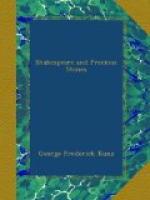While it is not unlikely that some of the royal or noble ladies who attended the performances of Shakespeare’s plays, while he was connected with the Globe Theatre, wore brilliant jewels, it is improbable that they were bedecked with the most valuable of their gems. The danger of being waylaid and robbed was much greater in those days than it is to-day, and it was probably only within palace or castle doors, or at some great State function, that the costliest jewels were worn. Hence nothing distantly approaching the rather excessive splendor of a New York or London opera night could ever have dazzled the poet-actor’s eyes.
In the case of plays acted before the court, however, the royal and noble ladies, undoubtedly, wore many of their finest jewels, as did also the sovereign and courtiers. Still, preoccupied as Shakespeare must have been with the presentation, or representation of the dramatic performance, he probably had little time or inclination to devote especial attention to these jewels.
No museum collections, properly so called, existed in Shakespeare’s day, from which he could have acquired any closer knowledge of precious stones or gems, although the conception of a great modern museum of art and science found expression in the “New Atlantis” of his great contemporary, Lord Bacon. The modest beginnings of the Royal Society of London, founded in 1662, cannot be traced back beyond 1645. The French Academy of Sciences, founded in 1666, was preceded by earlier informal meetings of French scientists, to which allusion is even made by Lord Bacon, who died in 1626. The Berlin Academy came much later, in 1700, and the St. Petersburg Academy was first established in 1725 by Catherine I, widow of Peter the Great. One society, the Academia Secretorum Naturae of Naples, goes back to 1560, and the Accademia dei Lincei of Prince Federico Cesi was founded at Rome in 1603. But of these Shakespeare could have known little or nothing.
That the poet knew, more or less vaguely, of America as a source of precious stones, as were the Indies, comes out in the farcical lines from The Comedy of Errors (Act iii, sc. 2), when one of the Dromios, in locating the various lands of the world on parts of his mistress’s body, to the query of Antipholus: “Where America, the Indies?” replies: “Oh, sir, upon her nose, all o’er embellished with rubies, carbuncles, sapphires”. This is the only mention of America in the plays.
A coincidence having its own significance is that April 23, the day of Shakespeare’s death and also his birthday, was the day dedicated to St. George, the patron saint of Merry England. The war-cry of England is given several times by Shakespeare, as, for example:
Cry, God for Harry, England and
Saint George!
Henry V, Act
iii, sc. 1.
First Folio, “Histories”, p. 77,
col. B, line 51.
God and Saint George! Richmond and Victory!
Richard III, Act
v, sc. 3.
First Folio, “Histories”, p. 203,
col. A, line 31.




